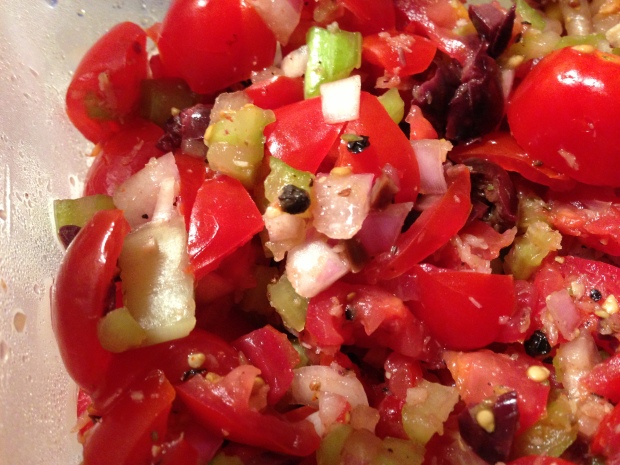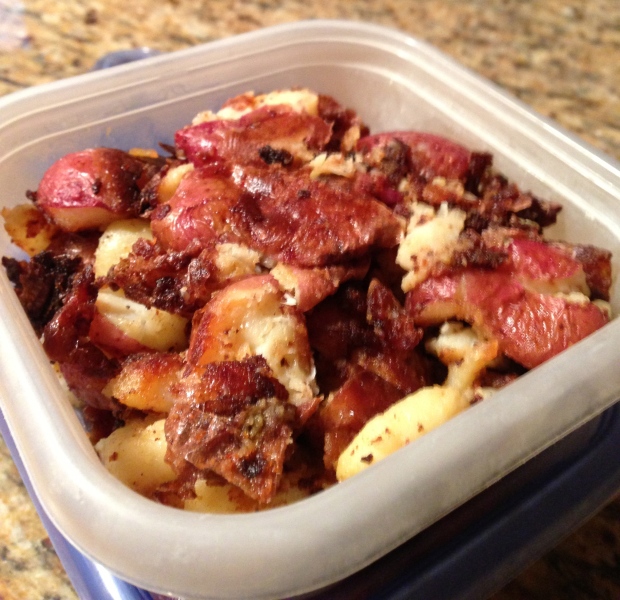So tonight my Aunt Barbara came in and my friends were coming over and I had been thinking about making this Bloody Mary-inspired salsa. I’m reasonably sure I got the idea from Bon Appetit, but when I went to make it I just said to myself, “What’s in a Bloody Mary?” and I put that in salsa.
Here’s what I did:
1. I cut up two pints of grape tomatoes, in rough pieces. Maybe 1/2″ dice? That’s what Aunt Barb is estimating.
2. I cut up three large stalks of celery, small dice.
3. I cut up one VERY LARGE lobe of shallot. I mean, huge. I don’t even know where the grocery store got shallots that big. So if you have normal-sized shallots, I’d go with three or four of those. Or you could use sweet onions, like Vidalia or Maya. But I had shallots. Huge shallots.
3. I salted and peppered the thing (kosher salt, fresh ground pepper, do I need to tell you?).
4. I chopped a handful of pitted Nicoise olives. I was thinking about using capers and they would be good too but a lot stronger. So as my lawyer mother is fond of saying, be guided accordingly.
5. I had this extra-hot horseradish in the fridge. I ended up using way more than I thought I would need, maybe about two tbsps. It really blended well but I added a little, then tasted, then added a little more, etc. So do that. Don’t add a whole glob at once; horseradish is hard to tame and how many tomatoes are you really going to buy at one time? Not enough to add more if you put in horseradish than you ought.
6. I also sprinkled in some cayenne (a very little bit!) and some celery seed. And then the tiniest bit of good balsamic vinegar. Not zomg amazing balsamic, just regular good balsamic.
Et voila! I made this about three hours or so before I served it. Maybe more than that. We got involved in some intense rounds of Rummikub so food ended up being served later than I had planned. I had intended for it to be eaten over steak but everyone seemed to eat it with their salads instead – the salad being romaine, more tomatoes, and mild blue cheese, with a very simple balsamic vinaigrette. I had it with the steak. I was right and they were wrong. But everyone seemed to like it anyway.
I also served these potatoes which I vaguely remember getting them from Gourmet but I make them a lot and they’re so easy that I don’t really remember their source. And they are unbelievably delicious.
1. Two pounds of little red potatoes. Boiled. Not too much. Fork tender but not mash-able. (You could use virtually any potato in this recipe. I used little red ones. If you use larger ones, it will be more of a pain in the butt.) After boiling, you can either use them right away or store them for later. I almost always store them for later because I generally boil them when I get home from the grocery store and figure out what I’m going to do with them later. Also, in this particular recipe, I think using them cold is helpful for the next step.
3. Lay them out flat on a baking sheet or large, flat platter. Smash them each with a fork. You don’t want them to completely lose their shape – although that will happen with some of them and it is no big deal — but you want lots of nice nooks and crannies to get all crispy. (And this is why it’s better if they’re cold – they’ll hold their shape better.) Also sprinkle some salt on them at this stage. And, if you want, some other spice. I haven’t but it certainly wouldn’t hurt. Just not cayenne – you will never be able to shut up your smoke detector.
4. Heat some oil in a pan. You want an oil that can take high heat. I usually use peanut, which really is the best for anything potato, but vegetable, canola, safflower, grape seed, even avocado oil – anything that can take high heat – would be fine. Extra-virgin olive oil would not destroy this dish, but that oil shouldn’t be taking this high heat, really. So if you have nothing else, fine, but why don’t you have anything else? Get something else.
5. Add potatoes in batches to the hot oil. Don’t crowd them. You want every nook and cranny to have its space to get nice and crispy.
6. As you take each batch off and put it in a bowl (I forgot this time but you really ought to line the bowl with paper towels to absorb the oil. Not that anyone seemed to mind.), grate a little Parmesan cheese over it. Or some other cheese, if you like. Just freshly grated by you with a microzester or very tiny-holed grater. (I love the microzester. It grates so easy!)
And potatoes! Yum, yum, ooh, delicious!
These should really be served right away, but like I said, Rummikub happened. So I heated them a little in the microwave. You know what? Once you fry something in oil and sprinkle Parmesan cheese on it, it’s really hard to fuck it up.









